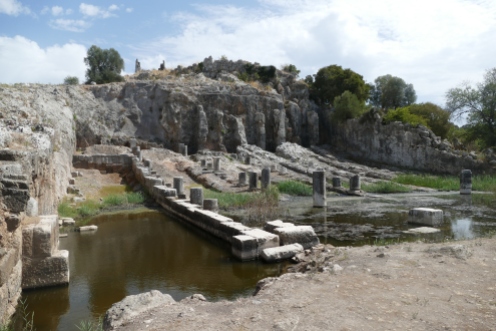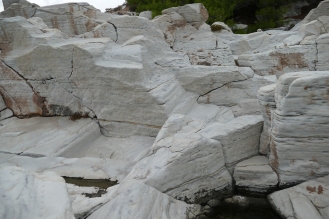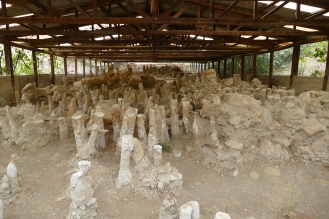Having been to Greece three times before, this first trip was a special treat since all of places were brand new to me. Our itinerary took us across the northern Peloponnese to Patras where we crossed into Aetolia. From there we ventured through Ambrakia and Akarnania and up north into Epirus. After completing our “western” portion of the trip, we drove northeast across the Pindos mountain range into Macedonia. The last phase of our journey took us through Thessaloniki, the Chalcidice, and then to the northern island of Thasos. After 14 days on the road, we zoomed back down to Athens. It was in a vast underestimation that I believed I should and could write about every single thing that we did on this trip. This post takes more of a topical approach than chronological, but the next post about Trip 2 will be much more thorough. I promise!
This trip was the first real chance for us Regular Members to get to know one another: bus rides were long, roommates rotated almost daily, and late dinners were devoured at night in mass groups. The bus was apparently a “VIP bus,” meaning that it had somewhat nicer seats, two table “booths” that sat groups of four facing one another, and a large round table in the back that could accommodate six. Plus it (strangely) had a counter-top with a non-functioning sink where Syl (our professor and fearless leader) stored scholarly books for reading—definitely no subtext here. As is typical of humans who are creatures of habit, most everyone sat in the same seat every time we piled onto the bus.
The intimidation factor (aka imposter syndrome) was and is very real—my fellow Regular Members have so much experience and knowledge. Most are archaeologists who have done digs in Cyprus, Pylos, Crete, and western Turkey (to name a few). Two historians (including myself) and a philologist round out the group of 14. In addition we had a few Associate Members and Professors join us who further added to our roving “think tank.” The research interests in our group span from the Neolithic and Bronze Age through the Classical and Hellenistic Periods and through to the Roman Empire. Observing the variety of personalities, intelligences, and habits/mannerisms made for a never-ending source of entertainment, enlightenment, and inspiration.
The only major requirement for each trip (other than being on time to the bus) is that each person present a 20-minute site report. Halfway through the trip, I tapped into my inner soothsayer to present on Dodona, the site of the oldest oracle in the Greek world (according to Herodotus, 2.52). Dodona is couched under Mount Tomaros in the heart of Epirus in northwestern Greece, and is arguably one of the most beautiful sites we visited. The earliest architectural remains date to the fourth century BC, but a majority of the site was developed by King Pyrrhus of Epirus (318-272 BC) who made Dodona the financial and religious capital of Epirus. The political significance is demonstrated by the large prytaneion for entertaining traveling dignitaries and other big wigs, as well as the bouletarion (assembly house) where the members of the Epirote League would have meet annually. But it was not all business at Dodona. A large theater that could accommodate roughly 15,000 people was certainly a must-see venue in antiquity (it was converted into an arena for gladiatorial games during the Roman period). As the seat of one of the most famous oracles in the eastern Mediterranean, pilgrims came from all over to submit inquiries to the priests of Zeus Dodonaios. Many of their inquiries survive in the form of lead tablets (lamellai, “strips”) which were found in and around the Sanctuary of Zeus where the main ritual of oracularizing (sp?) took place. The concerns of these wayfarers ranged from personal health and financial matters, occupational changes, and family concerns to the foreign policy of large city-states. The fact that most dealt with personal matters suggests that many of these inquires came from those who lived in and around Epirus, though it was obviously sought out by far-away peoples (Herodotus [1.46] records that Croesus of Lydia sent for the oracle at Dodona among many other oracles). The grandeur of the oracle was enhanced by (and perhaps due to) what the second-century AD traveler Pausanias described as the second oldest tree in Greece (Description of Greece, 8.23.5) – a tree that Homer referred to as the “high-crested oak of the god” (Odyssey, 19.297). Although the oak was probably unceremoniously chopped down in the fourth century AD by an Illyrian bandit, visitors can still come to Dodona to see the oak, though this one was planted in the 1980s.
There were several common themes that traveled with us in the histories of the sites we visited. In the west, Pyrrhus was a constant source of building and fortification, only to be ravaged by the Romans one hundred a fifty years later after the Third Macedonian War (171-168 BC) when much of Greece was incorporated into the growing Roman imperial machine. Cities like Cassope Calydon, and Stratos expanded and thrived during the Hellenistic Period. These names are not common in the general narratives of ancient Greek history—they were certainly not known to me before this trip! In this region of the Greek world, federal associations known as koina (sing. koinon) were common, and they provided a way for smaller city-states to enjoy the protection and solidarity of their neighbors. Koina such as the Aetolians and Acarnanians often quarreled with one another, but they were essential in fostering and safeguarding the political, military, and religious links of their members. Although they forged strong bonds, their varying and shifting attitudes towards the Romans and Macedonians embroiled them into numerous conflicts which was finally put to rest by Lucius Aemilius Paulus in 167 BC during his campaign against Philip V of Macedon—many Greek city-states in Epirus and western Greece were destroyed. Some places showed subsequent settlement, but after Octavian (the future Emperor Augustus) defeated the forces of Antony and Cleopatra at Actium in 31 BC, many inhabitants in western Greece around the Ambracian Gulf were uprooted and relocated to a new foundation dubbed Nikopolis (lit. “city of victory”).
In the north, the main protagonist was King Philip II (the father of Alexander the Great) who took major steps toward the expansion of Macedonia in the middle of the fourth century BC. He enacted reforms to the Macedonian military, united upper and lower Macedonia, and acquired lands in the Chalcidice, western Thrace, and Thessaly. Macedonian tombs seemed to be a common indicator of the Macedonian presence (we went to tombs at Aiani, Vergina, Lefkadia, and Philippi). Their characteristic white stuccoed facades with red and blue paint on the architrave and frieze is easily identifiable. The tombs at Vergina were by far the most elaborately displayed since the remains of Tomb #2 have been identified as those of Philip II—this story has been forcefully advocated since shortly after their discovery in 1977. This is a highly contested identification in academia for obvious (and not-so-obvious) reasons, nevertheless, Vergina has become integral to the national agenda of modern Greece (which they surely have the right to do). Tourists are wowed by the vast quantities of shimmering gold held carefully in glass cases under piercing white lights. No pictures were allowed, unfortunately, but these pieces are unforgettably highlighted because the rest of the exhibit is left dark as dusk.
A third main theme was the extent of the Mycenaean world. The Mycenaeans flourished during the Bronze Age (~1500-1200 BC), but was violently destroyed amid disturbances that affected the entire Eastern Mediterranean in the 12th century BC (i.e. around the time the historical Troy was destroyed). Mycenaeans can be most easily identified by their citadels and pottery. While their citadels are mostly confined to the Peloponnese, Attica, and Central Greece, their pottery has been found in northwestern and northern Greece. An impressive horde of cist burials (173!) at Voudeni in the northern Peloponnese was a fantastic way to start the trip. I appreciated that we could walk into most graves. Some had long ramps that descended 20 feet into the middle of the burial mound. The graves are empty now (save for one that had the skeletons of six or so people preserved in situ for visitors), either because they were robbed sometime in antiquity or their contents have been moved to a museum for preservation and study. Most every museum you go to, you will likely find some Mycenaean pottery. *A brief aside about pottery: while my eyes tend to glaze over pottery sherds in museums (unless they have nifty pictures or inscriptions), I am glad that others in our group appreciate them and give them the attention they deserve.* Pottery evidence does not necessitate the presence of Mycenaeans, but it does indicate the extent of their trade networks. This trip demonstrated that the extent of the Mycenaean world is much more extensive that I realized.
It was also great to have bits of modern Greek history thrown into our itinerary. Many of these places were documented by early antiquarian travelers to Greece, namely William Leake and François Pouqueville, among many more. These men left accounts of the various sites, monuments, and buildings they found, giving us modern scholars a dearth of additional archaeological knowledge to draw upon. Greece was subject to colonialist abuse in much of the modern period. Such visitors did not always exercise restraint on their journeys—the most famous case is perhaps the so-called “Elgin marbles,” which are the monumental marble friezes from the Parthenon taken in early nineteenth century. While in Thessaloniki, we were able to see copies of Las Incantadas (“The Enchanted Ones”—marble pillars with various Greek gods and goddesses) which were newly displayed only last month. The originals were taken to the Louvre in 1864. We visited Messolonghi on the northern Ambracian gulf where the Greeks made a valiant but eventually unsuccessful defense in their war for independence against the Ottoman Turks. It is also the place where the famous philhellene Lord Byron died (his heart is allegedly buried in the city). While my interest in the history of modern Greece is newly budding, my next goal is to gain a greater appreciation and understanding of the Byzantine Period so as to not skip from antiquity to the present, as is so often done not only in Greek history but also world history.
A return to a tangent on Thessaloniki is needed. Not to pull a Kanye here, but… Athens may be the largest city in Greece, but Thessaloniki definitely has the best vibe for a city boy like me. There is a modern energy in the city that is incredibly inviting and exciting. Perhaps the city was most memorable for me because it was one of two places that we stayed two nights, so there was simply more time to get acquainted. We did a five hour walking tour of the city and we heard about Thessaloniki’s history from antiquity to the present. I had no idea that after the Jews were expelled from Spain in 1492 that some 20,000 Sephardic Jews came to Greece, and many settled in Salonica (the name of Thessaloniki during the Ottoman period). Sephardic Jews accounted for a majority of the population for a long time. Jews participated in the defense against the Italian invasion in 1940 and Nazi invasion of 1941. Having such a large population of Jews and being so far in the north, they were an obvious target for ghettoization and the eventual deportations in March 1943 to concentration camps. About 96% of the Jews of Thessaloniki died in concentration and labor camps (~60,000 people). The Jewish Museum in Thessaloniki was excellent for its documentation of the various Jewish experiences before, during, and after the Second World War. The Jewish past of the city is not gone but surely obscured amid the hustle and bustle, and only a thousand or so Jews live there today. After visiting the Jewish museum, I went on a waterfront run with my bus buddy Peter, and we were certainly not alone on the vibrant cobbled and paved boardwalk on that windy afternoon. It appears to be an active city, and the streets were always crowded. Thessaloniki also had some good eats. A quick bite to eat for lunch that day was, of course, a gyro—but they do gyros differently in northern Greece. Instead of the usual southern Greek tzatziki (a sauce of Greek yogurt, cucumber, garlic, dill, and lemon juice), northern Greeks do a splattering of “barbeque sauce” and mustard. I have to say that it was a welcome change, but not one I would want all the time. The first night, our friend Tim led the rest of us guys out to a Syrian restaurant that he had been to before, and it did not disappoint—finally some spicy heat (no offense, Greece)! The journey there was very multicultural. Imagine three American Ph.D. students (including myself, Peter, and Simone, an Italian native) in a taxi speaking auf Deutsch with our German cab driver (who has lived in Greece for seven years after meeting his wife in Australia) on their way to a Syrian restaurant in Greece. Craft beer is also becoming a thing in Greece, and there was no shortage of watering holes around our hotel. One lucky place hosted Peter and I for a drink before calling it a day.
The next day we began our journey eastward through the Chalcidice for two days and then onto the island of Thasos where we spent another two days. Thasos was a great place too, but it was quite gloomy and windy, and it almost always seemed to be on the verge of raining. Thankfully, we escaped a deluge during our five hour city wall walk and our adventures at the marble quarries in Aliki. The last two days of the trip passed by rather quickly as we made our way back west through Kavali, the Neolithic site at Dikili Tash, Philippi, Methone, and Pydna before staying the night at the foot of Mount Olympus. The last day was mostly spent driving after a stop at Dione to see the museum and sanctuary. A miserable bunch of dogs attached themselves to our group, but after being bored by the great report on the site, some males unsuccessfully tried to woo a female who, once the males were chased off by one of our professors, proceeded to puke up the green pond water she had drank. Our presenter, Megan, was a great sport for putting up with these shenanigans on the last day of the trip. Our last site before returning to Athens was at Thermopylae where the famous battle during the Persian Wars occurred. The nearby hot springs for which the site got its name is still in use as evidenced by the throngs of men and women letting the steamy water smolder around them. In an unfortunate case of irony, about fifty feet away is a home for Syrian refugees. In antiquity Thermopylae was a holy ground where the 300 Spartans died (though there were actually more Greeks who often get left out) in their attempt to prevent the Persians from invading Greece. It is often depicted as a place where the “West” warded off “Eastern hordes.” Now, however, it is a home to the most vulnerable fleeing desperate situations in the Middle East and beyond.
I cannot think of a good way to end this post, so I will just leave you with this reminder that I am privileged to be spending so much time in modern Greece.
Post Script: The tragic event in Las Vegas has been especially troubling news and a reminder that the world I have temporarily left is not at peace. May we all continue to work at making the world a better and safer place for all. Be well, and take care of each other.












Babe, thank you for your wonderful writing and beautiful pictures I Am learning a lot from you. Xoxo can’t wait for your next blog post.
LikeLike